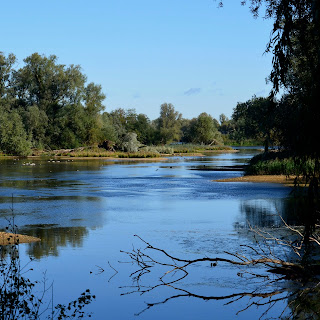From the breeding grounds in Greenland, Iceland, Siberia in the high Arctic and from Northern Europe come huge clanging battalions of geese, swans and wildfowl. Did you know that over half a million wild geese overwinter in various areas of The British Isles ?
 |
| Paxton Pits Nature Reserve. |
We humans may dread the onset of Winter, but to these long distance travellers our colder, grey and shorter days are a very welcome relief from the harsh conditions they would have had to face if they had stayed on their breeding grounds.
During the Summer, Veronica and I visited Svalbard, a series of remote Norwegian Islands, way above the Arctic Circle. Here barnacle geese were still in family groups, feeding on the low lying land which surrounds the few human settlements. By the time you read this, all of the 40,000 plus population of this race of barnacle goose will have arrived back on their wintering grounds on the Solway Firth in southern Scotland – quite a remarkable journey !
Close to home, the Norfolk coast will host many thousands of dark bellied Brent geese, all the way from Siberia, along with a large percentage of Icelandic pink foot geese, making the UK one of the most important wintering areas for geese in Europe.
 |
| The viewing gallery at Welney Wash. |
Here in the St Neots we are fortunate to live near to so many great areas for wintering wildfowl – such as the Fens, Nene and Ouse Washes, so close for local visits.
If you have never been to the fantastic Wildfowl and Wetland Centre situated at Welney, close to Ely, but actually just within Norfolk, promise yourself a visit this Winter. There you can enjoy close views of a huge range of wintering wildfowl, especially the rare Whooper swans, all the way from Iceland. The best part is the fact that viewing is from a range of birdwatching hides – the main observatory is even centrally heated – and you cannot get better than that can you ? There is also a café and gift shop, making it the ideal day out in these colder days.
You do not even need to travel for excellent wildlife experiences this Winter. Just around the corner you will find Paxton Pits Nature Reserve, owned by Huntingdon District Council and financially supported by The Friends of Paxton Pits Nature Reserve. Each Winter We host over a dozen different species of wildfowl, and this year the wigeon duck arrived in late August, and will stay with us until it is time to return next Spring to its breeding grounds. Paxton Pits can hold significant numbers of gadwall, mallard, shoveller, teal and tufted ducks, but numbers can fluctuate depending on the climate and water levels.
If the weather hardens, we can also expect to encounter such Arctic birds as the fish eating goosander and smew. Don’t forget that we also have excellent birdwatching hides and a well-stocked information visitor centre and café.
By the way, please feed your garden birds, and keep the birds’ water supply free from ice – you really can make a huge difference to just how our local birds make it through the Winter.
Enjoy your wildlife watching this Winter, and if you can please visit us at Paxton Pits very soon – a warm welcome awaits !
Trevor Gunton for FPPNR, October 2019